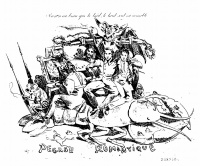Cult of ugliness
From The Art and Popular Culture Encyclopedia
| Revision as of 12:10, 9 April 2014 Jahsonic (Talk | contribs) ← Previous diff |
Revision as of 08:23, 22 April 2014 Jahsonic (Talk | contribs) Next diff → |
||
| Line 8: | Line 8: | ||
| |} | |} | ||
| [[Image:L'Absinthe (1876) - Edgar Degas.jpg|thumb|right|200px|''[[L'Absinthe]]'' ([[1876]]) - [[Edgar Degas]]]] | [[Image:L'Absinthe (1876) - Edgar Degas.jpg|thumb|right|200px|''[[L'Absinthe]]'' ([[1876]]) - [[Edgar Degas]]]] | ||
| + | [[Image:Pegase romantique.jpg|thumb|right|200px|The "[[Pégase romantique]]" caricature by [[Jean-Gabriel Scheffer]] | ||
| + | <br> | ||
| + | Left to right: [[Petrus Borel]], [[Victor Hugo]], and [[Alexandre Dumas]] | ||
| + | <br> | ||
| + | Its motto reads "[[Rien n'est beau que le laid, le laid seul est aimable|Only the ugly is beautiful, only the ugly is likeable]]." | ||
| + | ]] | ||
| {{Template}} | {{Template}} | ||
| '''Cult of ugliness''' refers to a relatively new phenomenon – largely coinciding with the arrival of [[modern art]] – in the history of [[art theory]]: the rejection of classical [[beauty ideal]]s and the embracing of [[ugliness]]. | '''Cult of ugliness''' refers to a relatively new phenomenon – largely coinciding with the arrival of [[modern art]] – in the history of [[art theory]]: the rejection of classical [[beauty ideal]]s and the embracing of [[ugliness]]. | ||
Revision as of 08:23, 22 April 2014
|
Consideration 1: The difference between the grotesqueries and incongruities that had existed since Antiquity (continuing with Bosch and Mannerism) on the one hand and the modernist cult of ugliness on the other, is that the former was full of awesome laughter and the latter was deadly serious. Consideration 2: The sublime was the first aesthetic category to diverge from the beauty of the pastoral landscape and the beauty of the feminine form, and in doing so was the first cultural tendency to subvert classic aesthetics. --JW Geerinck |

Left to right: Petrus Borel, Victor Hugo, and Alexandre Dumas
Its motto reads "Only the ugly is beautiful, only the ugly is likeable."
|
Related e |
|
Featured: |
Cult of ugliness refers to a relatively new phenomenon – largely coinciding with the arrival of modern art – in the history of art theory: the rejection of classical beauty ideals and the embracing of ugliness.
A predecessor for the cult of ugliness was Francis Bacon who said "There is no excellent beauty, that hath not some strangeness in the proportion," not calling the ugly beautiful just yet but "strangeness in proportion" beautiful.
The Romantics where the first to profess a true cult of ugliness with the anonymous dictum "Only the ugly is beautiful, only the ugly is likeable" and Victor Hugo saying "Le beau n’a qu'un type ; le laid en a mille."
Baudelaire picked up on both Bacon and Hugo and said "Le beau est toujours bizarre".
Naturalistic works of literature such as those of Émile Zola often include uncouth or sordid subject matter. They exposed the dark, harshness of life, including poverty, racism, prejudice, disease, prostitution and filth. These 'warts and all' novels were often criticized for being too blunt.
In art, French realist painter, Gustave Courbet's large canvas A Burial At Ornans (1850) is a possible originary date of the modernist cult of ugliness.
In his 1913 essay The Serious Artist, Ezra Pound discusses two types of art; The "cult of beauty" and the "cult of ugliness". He compares the former with medical cure and the latter with medical diagnosis, and goes on to write "Villon, Baudelaire, Corbière, Beardsley are diagnosis."
Breton in 1928 said La beauté sera CONVULSIVE ou ne sera pas.
Equating modern art with ugliness Clement Greenberg suggested that "all profoundly original art looks ugly at first" in 1945.
Anais Nin stated the following on the "cult of ugliness" in The Novel of the Future (1969):
- "I think that natural truths will cease to be spat at us like insults, that aesthetics will once more be linked with ethics, and that people will become aware that in casting out aesthetics that they also cast out a respect for human life, a respect for creation, a respect for spiritual values. Aesthetics was an expression of man's need to be in love with his world. The cult of ugliness is a regression. It destroys our appetite, our love for our world."
Further reading
- The Aesthetics of the Ugly (1853) by German philosopher Karl Rosenkrantz
- Venus in Exile (2001) by Wendy Steiner.
- On Ugliness (2007) by Umberto Eco
See also
- Anti-aesthetics
- Death of art
- Diane Arbus and Nan Goldin
- Form follows function and ornament is crime
- Faultlines in 20th century art
- Grotesque
- Iron, steel, concrete and glass
- Kalliphobia
- Naturalism
- Ugliness
_-_Edgar_Degas.jpg)

